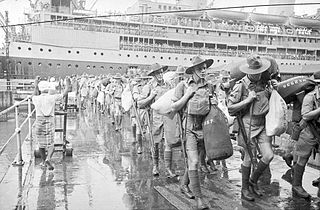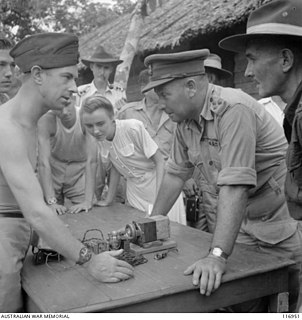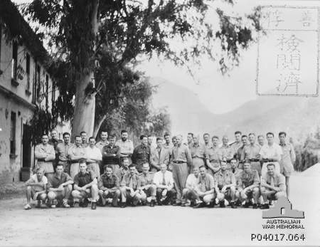
The 8th Division was an infantry division of the Australian Army, formed during World War II as part of the all-volunteer Second Australian Imperial Force. The 8th Division was raised from volunteers for overseas service from July 1940 onwards. Consisting of three infantry brigades, the intention had been to deploy the division to the Middle East to join the other Australian divisions, but as war with Japan loomed in 1941, the division was divided into four separate forces, which were deployed in different parts of the Asia-Pacific region. All of these formations were destroyed as fighting forces by the end of February 1942 during the fighting for Singapore, and in Rabaul, Ambon, and Timor. Most members of the division became prisoners of war, waiting until the war ended in late 1945 to be liberated. One in three died in captivity.

The Royal Regiment of Australian Artillery, normally referred to as the Royal Australian Artillery (RAA), is a Regiment of the Australian Army descended from the original colonial artillery units prior to Australia's federation. Australia's first guns were landed from HMS Sirius and a small earthen redoubt built, near the present-day Macquarie Place, to command the approaches to Sydney Cove. The deployment of these guns represents the origins of artillery in Australia. These and subsequent defences, as well as field guns, were operated by marines and the soldiers of infantry regiments stationed in Australia. Unlike their British and Canadian equivalents, there are no regiments of horse artillery in the order of battle of the Royal Australian Artillery. The First World War saw the raising of 60 field, 20 howitzer, and two siege batteries along with the heavy and medium trench mortar batteries. Until 19 September 1962 the Australian Artillery was referred to as the 'Royal Australian Artillery', however, on this date Queen Elizabeth II granted the RAA the title of 'The Royal Regiment of Australian Artillery'. The Regiment today consists of Regular and Reserve units.

The 16th Regiment, Royal Australian Artillery is the Australian Army's only ground-based air defence (GBAD) unit. It also provides sense, warn and locate, ground liaison, and joint terminal attack control capabilities. Part of the Royal Regiment of Australian Artillery (RAA), the regiment is responsible for protecting a wide range of military assets during wartime, ranging from Army units in the field to providing point defence to the Royal Australian Navy's support ships and air defence to Royal Australian Air Force air bases. Prior to being equipped with the currently in-service RBS-70 surface-to-air missile system, the regiment was equipped with the Rapier systems for 25 years. The regiment is based at Woodside, South Australia, but frequently deploys with other Australian and allied units on operations and defence exercises. It is part of the 6th Brigade.
The 48th Field Battery, Royal Australian Artillery was an artillery battery of the Australian Army. The battery traced its lineage back to a unit that was formed for service during the First World War. Assigned to the 9th Brigade, it was located at Keswick Barracks in South Australia until mid-2013 when it was amalgamated with the Launceston-based 16th Field Battery, to form the 6th/13th Light Battery.
The 4th Regiment, Royal Australian Artillery is an artillery unit of the Australian Army. Currently it provides close artillery support to the 3rd Brigade and is based at Chau Pha Lines, Lavarack Barracks in Townsville, Queensland. The regiment was raised in its current form in 1960 and is currently re-equipping with M777A2 lightweight towed howitzers. The regiment deployed during Australia's commitment to the Vietnam War and has subsequently deployed to Singapore and East Timor.

Brigadier Sir Thomas Charles Eastick, was a senior Australian Army artillery officer during World War II and a post-war leader of the principal ex-service organisation in South Australia. He commanded the 2/7th Field Regiment during the First and Second Battles of El Alamein in the Western Desert campaign in North Africa in 1942, for which he was appointed as a Companion of the Distinguished Service Order. Upon return from the Middle East he commanded the artillery of the 7th Division during the final stage of the Salamaua–Lae campaign and then during the Markham, Ramu and Finisterre campaigns in New Guinea between August 1943 and April 1944, and then held the same role for the 9th Division during the Borneo campaign in 1945. Eastick was military governor of the Raj of Sarawak after taking the Japanese surrender at Kuching, and led the army's peacetime Central Command headquartered in South Australia from 1950 to 1953. He was the state president of the Returned Sailors’, Soldiers’ and Airmen’s Imperial League of Australia between 1950 and 1954 and again from 1961 to 1972. He was made a Companion of the Order of St Michael and St George in 1953, and knighted by Queen Elizabeth II in 1970, in both cases for his services to ex-servicemen.
The 2nd/10th Field Regiment, Royal Australian Artillery was an Australian Army Reserve artillery regiment, assigned to the 2nd Division. Formed in 1991, and based in Victoria, the regiment drew on the lineage of a number of disbanded units that had previously existed in that state. In 2013, the regiment was reduced to a single battery, designated the 2nd/10th Light Battery. It was assigned to the 5th/6th Battalion, Royal Victoria Regiment, and tasked with training artillery observers and organic fire support to the battalion. It was equipped with the L16 81mm Mortar as the primary armament, while M2A2 Howitzers were retained for ceremonial purposes.

'A' Field Battery is an artillery battery of the Australian Army. The unit has been in existence since 1871, having originally been raised as part of the New South Wales colonial defence force. As part of several different larger formations, the battery has served in many conflicts including the Sudan Campaign, the Second Boer War, the First World War, the Second World War, the Malayan Emergency, Confrontation, and the Vietnam War. Today it is part of the 1st Regiment, Royal Australian Artillery, attached to the 7th Brigade based at Enoggera, Queensland. It was previously an airborne unit, but no longer maintains that role. It is currently equipped with M777 howitzers.
The 7th Field Regiment, Royal Australian Artillery was an Australian Army Reserve artillery unit with its headquarters at Pymble, New South Wales, and was part of 8th Brigade until it was disbanded in early 2013.

The 2/22nd Battalion was an infantry battalion of the Australian Army. Raised as part of the Second Australian Imperial Force for service during World War II, the battalion formed part of the 23rd Brigade, attached to the 8th Division. It was captured by the Japanese during the Battle of Rabaul in 1942. After being captured, the battalion was not re-raised and a large number of its personnel died in captivity; those that did not were returned to Australia at the end of the war in 1945.

The 2/1st Field Regiment was an Australian Army artillery regiment raised as part of the all volunteer Second Australian Imperial Force during World War II. Formed in October 1939, the regiment was assigned to the 6th Division. Shortly after it was raised, the regiment was deployed to the Middle East, where it was briefly re-roled as an anti-aircraft regiment before returning to the field artillery role. In 1941, the regiment served in North Africa and in Greece, before being withdrawn back to Australian in early 1942, following Japan's entry into the war. In late 1942, and early 1943, the regiment took part in the defence of Port Moresby during the fighting along the Kokoda Track, before taking part in the Battle of Buna–Gona and the defence of Wau, remaining in New Guinea on garrison duties until August 1943. Withdrawn to Australia, a long period of training followed before the regiment took part in its final campaign of the war Aitape–Wewak campaign in 1945.

The 2/3rd Field Regiment was an Australian Army field artillery regiment that was raised for service during the Second World War. Formed in 1939 and assigned to the 6th Division, the regiment was deployed to the United Kingdom to defend against a possible invasion in 1940 before being sent to North Africa, where it briefly saw action prior to being sent to Greece and Crete in 1941. In 1942, the regiment returned to Australia, after which it did not see action again until late in the war when it was committed to the Aitape–Wewak campaign in 1944–45. Following the end of the war, the regiment returned to Australia and was disbanded in January 1946.

The 2/7th Field Regiment was an Australian Army field artillery regiment that served during the Second World War. Formed in mid-1940 and assigned to the 9th Division, the regiment was deployed to North Africa, where it saw action around Tobruk in 1941 and in the First and Second Battles of El Alamein in 1942. It also undertook garrison duties in Syria and Egypt. In 1943, the regiment returned to Australia, after which it did not see action again until late in the war when it was committed to the landing at Tarakan in 1945. Following the end of the war, the regiment returned to Australia and was disbanded in January 1946.

The 2/14th Field Regiment was an Australian Army artillery unit that served during the Second World War. Raised in late 1940 as part of the 8th Division, the regiment remained in Australia as a garrison force in Darwin when the division's infantry brigades were sent to various places around Southeast Asia to meet the threat posed by Japan. As a result, it did not deploy overseas until late 1943. In New Guinea, the regiment supported the 5th Division's operations on the Huon Peninsula throughout 1944 before deploying with them to New Britain in early 1945. From then, until the end of the war, the regiment engaged in operations against the large Japanese garrison on the island. At the end of the war, the 2/14th briefly undertook garrison duties on Rabaul as part of the 11th Division before returning to Australia and disbanding in January 1946.
The 103rd Medium Battery is an artillery battery unit of the Royal Australian Artillery. The battery was formed in 1916, known as the 103rd Field (Howitzer) Battery and served during World War I. Its successors have fought in the Indonesia–Malaysia confrontation and the Vietnam War and the battery is currently part of the 8th/12th Regiment, Royal Australian Artillery, based in Darwin, Northern Territory, as part of the 1st Brigade.

The 1st Mountain Battery was an Australian Army artillery battery formed in July 1942, that served during the Second World War, seeing action against the Japanese during the Battle of Buna–Gona and the Salamaua–Lae campaign in 1942–43. The unit was added to the 1st Parachute Battalion in August 1944 providing an organic indirect fire support, equipped with Short 25-pounder guns, but did not see further action in this role. The battery was disbanded in 1946.
T Battery Royal Artillery is an air defence battery of the Royal Artillery that serves with the British Army's 12 Regiment Royal Artillery. It is stationed at Baker Barracks, Thorney Island, West Sussex.
The 9th Regiment, Royal Australian Artillery is an artillery regiment of the Australian Army. It draws lineage from an artillery unit raised in 1903, which provided personnel to artillery units raised for service during World War I seeing action on the Western Front. It was mobilised for service during World War II and undertook defensive duties in Australia before being disbanded in 1944. The regiment was re-raised as part of the Australian Army Reserve in 2018, and currently provides artillery support to the 2nd Division. It consists of six light batteries, which are based at numerous depots around the country. The regiment's headquarters is based in Sydney, New South Wales.
The 23rd Regiment, Royal Australian Artillery was an Australian Army artillery regiment of the Australian Army. Raised in 1948 as a Citizen Military Forces anti-tank unit designated the 3rd Anti-Tank Regiment, it was converted to a field artillery regiment in the 1950s. It supported the 5th Brigade until being reduced to a battery-sized sub unit, and assigned to the 9th Regiment, Royal Australian Artillery in 2018.












